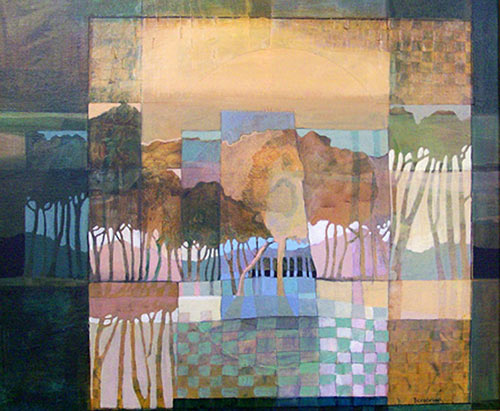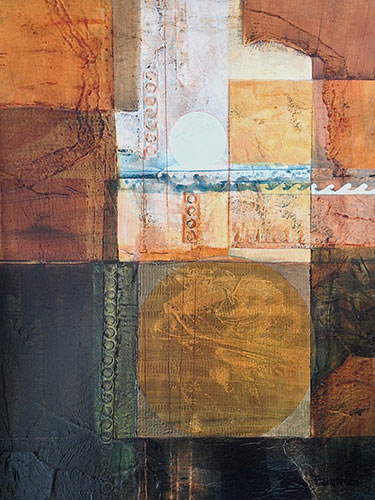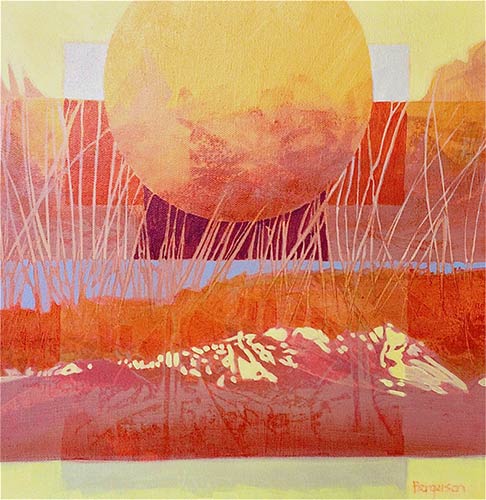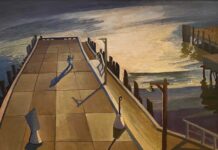Quietly working in her studio along the shores of the Mississippi River, artist Judith Bergerson continues to achieve profound joy by exploring the ways abstraction and representation can move the soul.
There is something calming and fulfilling when one gazes upon the beautiful multi-media works by Judith Bergerson, a feeling the artist shares during her intuitive creative process. “Often I have little idea of how a painting is going to turn out when I begin,” she says. “I love for the work to reveal itself, to evolve organically as it comes into being. I continuously play with different texture, shape, and line arrangements and compositions until I know where the work wants to go.” For Bergerson, it is precisely this process of give-and-take and visual problem met with design solution that gives her the utmost creative pleasure and serenity.

A Minnesota native, Bergerson has always been interested and fascinated by art. “I can distinctly remember when I was a little girl seeing this amazing painting by Lyonel Feininger at the institute [Minneapolis Institute of Arts], she says. “I recall loving how these tall buildings and forms would meld and interact with strong angular lines and planes of color. His inspiration really surfaces in my work.” Although she and her husband, Mark, would eventually own a custom framing business for over 30 years, Judith never lost her desire to create. Bergerson received her BFA from St. Olaf College in Northfield, Minnesota, but has additionally studied at institutions all across the United States, including the California College of Arts and Crafts and the C.W. Post College of Long Island University.

Although Bergerson draws upon Feininger’s precedent, her artworks go much further, exploring the juxtaposition between representation and abstraction, each having an amazing process characterized by the methodical layering of acrylic paint, gesso, colored pencil, and found textures — among other elements. The resulting collages are exquisitely beautiful from a formal perspective, intertwining recognizable forms of trees and plants with abstract organic and geometric planes and shapes. “I enjoy that play between what is two-dimensional and three-dimensional, the oscillation between the transparent and opaque or a saturated color next to a muted tone,” says the artist. Although she doesn’t keep count, some works could require as many as 50 layers of different media, or whatever the artist feels is necessary for a successful composition. Occasionally the design puzzle proves too much, in which case Bergerson sets the work aside and begins anew. She often has several pieces in process, the finishing touches and solutions sometimes coming quickly, while others take months, maybe years.

Asked what she hopes viewers take away from the works, Bergerson suggests, “That’s largely up to them. I want my audience to form their own relationships with the work, to bring their own subjective experiences to the piece and decide what the work means to them. I don’t necessarily want my interpretation of the piece to affect theirs. For me, that is one of the most beautiful elements of art.”

Bergerson’s “Evening Shadows” is an outstanding representative example. In a large vertical format, the viewer finds a wonderful arrangement of silhouetted trees of varying size and color that are layered and overlapped in a way to suggest spatial depth. One’s eyes play among what the brain interprets as foreground, middle, and background. Toward the bottom of the canvas, a group of birds stand perched on a strong horizontal line, a line that is repeated, moving up the center of the image. Quick consideration of the work offers the impression of pure abstraction, but closer and extended observation reveals representational forms. A common motif in Bergerson’s oeuvre can also be detected toward the upper right of the canvas, barely visible among the treetops: a perfect circle.

Future works will undoubtedly continue to play with a variety of media, but Bergerson says she’s looking forward to exploring drawing more in her works. “Rather than being paintings with drawing media and other collaged materials, I’m interested in exploring drawings with painting media,” she says. “Perhaps that could lead to more representation in my work — who knows?” Whatever they may be, she can rest assured that there will be many eagerly waiting and watching.
Bergerson is a signature member of the National Collage Society; her works can be found at Art Beat Gallery in Hayward, Wisconsin, Up North Gallery in Lindstrom, Minnesota, and Clay Bay Gallery in Door County, Wisconsin.
To learn more, visit Judith Bergerson.
This article was featured in Fine Art Today, a weekly e-newsletter from Fine Art Connoisseur magazine. To start receiving Fine Art Today for free, click here.







